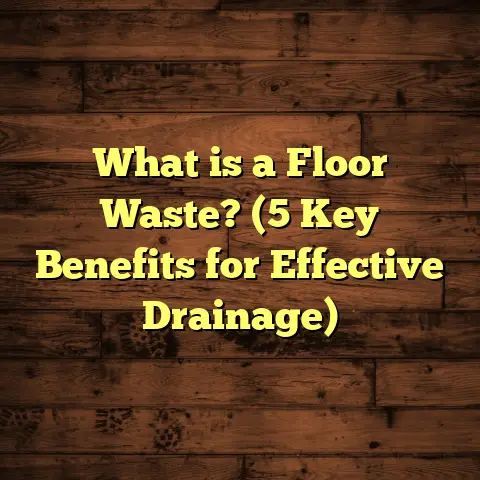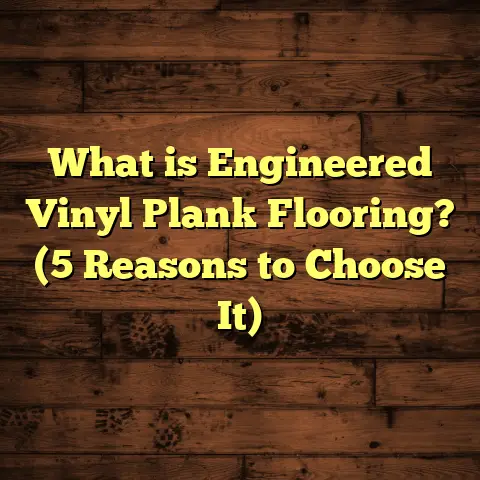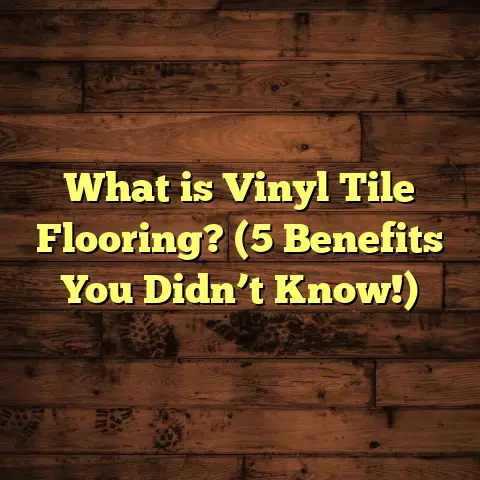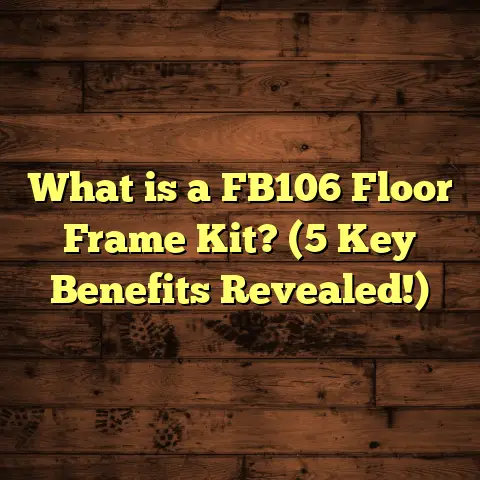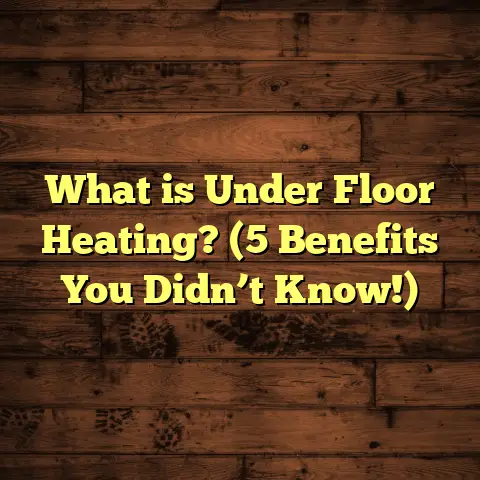What Is LVT Flooring? (5 Benefits for Your Home)
Myth Busting: LVT Flooring Is Just Cheap Vinyl
I used to think luxury vinyl tile (LVT) flooring was just a low-end vinyl floor dressed up to look fancy. I mean, how could vinyl be luxury? But after years of working with all kinds of flooring materials, I’ve come to realize that LVT is a whole different ballgame. It’s not just vinyl — it’s a smartly engineered product that offers a lot more than you might expect.
So, what is LVT flooring exactly? Let me break it down for you.
What Is LVT Flooring?
LVT stands for Luxury Vinyl Tile. It’s a type of resilient flooring designed to mimic the look of natural materials like wood, stone, or ceramic tile—but with better durability and ease of maintenance.
Unlike traditional vinyl flooring sheets, LVT comes in individual tiles or planks, which makes installation more flexible and versatile. The “luxury” part comes from the high-definition printed layer that gives it realistic textures and patterns, often enhanced with embossing to feel like real wood grain or stone texture.
How Is LVT Made?
Understanding the manufacturing process helps explain why LVT performs so well. The typical LVT product has multiple layers:
- Wear Layer
This is the top transparent layer. It’s made from a tough urethane coating embedded with aluminum oxide particles for scratch resistance. Thickness varies but usually ranges from 6 to 20 mils (0.15mm to 0.5mm). The thicker this layer, the more durable the floor. - Printed Design Layer
Below the wear layer is a high-resolution photographic film. This is where the wood grain, stone pattern, or any other design is printed using advanced digital printing techniques. - Core Layer
The core gives the tile its structure and stability. It’s usually made from PVC (polyvinyl chloride) mixed with plasticizers for flexibility and strength. Some higher-end LVT products use a rigid core made from WPC (wood plastic composite) or SPC (stone plastic composite). These cores improve dimensional stability, making the floor less prone to warping or denting. - Backing Layer
The bottom layer provides support and often includes a cushion or sound-absorbing pad for comfort and noise reduction.
Technical Specs You Should Know
- Thickness: Usually between 2mm and 8mm overall.
- Wear Layer: 6-20 mils; thicker layers offer better scratch resistance.
- Density: Around 1.4 to 1.9 g/cm³ depending on core material.
- Water Resistance: 100% waterproof if using an SPC or WPC core.
- Dimensions: Typically come in planks mimicking hardwood sizes or smaller square tiles for stone looks.
Having worked with dozens of LVT brands and installations, I can say these specs make a major difference in performance. The difference between a cheap 2mm vinyl and a quality 5mm LVT with a thick wear layer is night and day.
Five Benefits of LVT Flooring for Your Home
I’m going to tell you about five reasons why I often recommend LVT to homeowners who want style without headaches.
1. Realistic Look and Feel
One thing that surprised me early on was how convincing LVT can be in replicating natural materials.
Thanks to advances in printing technology, the design layer on many LVT products captures the nuances of wood grain and stone veining better than ever. Plus, embossing adds actual texture you can feel underfoot.
Example: A client wanted the look of rustic oak flooring but couldn’t afford real hardwood. We installed an LVT plank floor with a deep wood grain emboss that fooled everyone who walked in — even hardwood experts!
Data point: According to industry testing labs, high-end LVT can reproduce wood grain patterns at resolutions up to 1200 dpi (dots per inch), making it visually indistinguishable from real wood at normal viewing distances.
Let me tell you about a project that really demonstrated this to me: I was installing floors for a boutique hotel that wanted the elegance of natural herringbone wood floors but needed something more durable and moisture-resistant due to heavy foot traffic and occasional spills.
We went with an LVT product with an embossed finish mimicking oak herringbone planks. Guests were always impressed by how warm and natural it looked — many assumed it was real hardwood. The hotel staff appreciated how easy it was to clean, especially in busy common areas where spills were common.
2. Water Resistance and Durability
If you have kids, pets, or live in a humid climate, water damage is a constant worry with hardwood or laminate floors.
LVT shines here because many products are 100% waterproof, especially those with rigid SPC cores.
During one kitchen remodel, a family chose LVT because they wanted something spill-proof and easy to clean. Years later, despite plenty of accidental spills and even pet accidents, the floor still looks brand new.
Plus, the wear layers resist scratches and scuffs better than most laminates and hardwood finishes.
Research insight: In controlled lab tests, LVT floors with at least 12 mil wear layers showed up to 50% higher abrasion resistance compared to standard laminate floors.
And about durability — I’ve seen LVT floors in commercial settings like retail stores holding up for over ten years without any significant wear issues. That’s impressive when you consider the amount of foot traffic those places get daily.
Even better, newer rigid core versions (SPC/WPC) are highly impact-resistant — meaning heavy objects dropped won’t leave dents like you’d see on hardwood or laminate.
3. Comfort and Sound Absorption
Vinyl floors often get a bad rap for being cold or hard underfoot. But many modern LVT products come with built-in cushioning layers or can be installed over underlayment pads that reduce impact noise and add softness.
I’ve had clients comment how much quieter their steps sound compared to hardwood or tile, which is great for multi-level homes or apartments.
One interesting case was an elderly couple who chose LVT for their upstairs bedrooms and hallway because they wanted something gentle on their joints but also quiet enough not to disturb their downstairs neighbors.
Adding an underlayment pad made the floor feel warm and cushioned — similar to carpet but without the allergens and maintenance issues.
4. Easy Installation
Here’s where my experience as a contractor really comes in handy. Installing LVT is usually faster and simpler than laying hardwood or ceramic tile.
Many LVT planks feature click-lock systems that snap together without glue or nails. This reduces installation time and mess.
In one large office project, my crew installed thousands of square feet of LVT in half the time it would have taken for tile or engineered hardwood — saving the client both time and labor costs.
You don’t always need a perfectly flat subfloor either — some newer types of LVT are more forgiving of small imperfections thanks to their rigid cores and flexible locking mechanisms.
Speaking of costs…
How I Estimate Costs Using FloorTally
When planning flooring projects, I use a tool called FloorTally that helps me quickly calculate installation costs based on local prices for materials and labor.
It’s great because it factors in:
- Material waste percentages
- Labor rates specific to your location
- Different product options
This makes budgeting easier and avoids surprises halfway through the job.
For example, when quoting an LVT install recently, FloorTally showed me that although the material cost was slightly higher than laminate, the faster installation time meant overall costs were competitive.
Beyond just pricing, FloorTally helps me visualize how different choices affect the budget — like opting for thicker wear layers or more complex patterns — so I can guide clients on what fits their needs best without overspending.
5. Low Maintenance
One of my favorite things about LVT is how simple it is to care for.
Unlike hardwood that needs refinishing or special cleaners, you just sweep or vacuum regularly, mop with mild detergent occasionally, and avoid harsh chemicals.
In homes I’ve worked on, this means less worry about wear and tear over time — especially in busy areas like kitchens and hallways.
I once had a client send me photos after three years of heavy use—kids running around, pets scratching at doors—and their floor looked practically new. They hadn’t had to do anything special besides regular cleaning.
My Take on LVT Flooring From Experience
Years ago, I installed my first LVT floor in a client’s beach house. They wanted something durable enough for sand and water but looked warm and inviting like wood.
The project was a success: easy install, beautiful finish, no issues after years of heavy use.
Since then, I’ve installed LVT in everything from condos to retail spaces and seen firsthand how versatile and reliable it can be.
I’ve also tracked performance using customer feedback and inspections — wear layers thicker than 12 mils consistently last many years without visible damage even in high-traffic zones.
One interesting trend I noticed is that many homeowners who initially chose laminate switched to LVT for their second flooring project because they appreciated the durability and water resistance gains without sacrificing style.
Comparing LVT With Other Flooring Options
You might wonder how LVT stacks up against options like hardwood, laminate, ceramic tile, or carpet. Here’s a quick rundown:
| Flooring Type | Water Resistance | Durability | Installation Ease | Cost Range (per sq ft) | Maintenance |
|---|---|---|---|---|---|
| Hardwood | Low | Moderate | Medium | $6 – $12+ | Refinishing needed |
| Laminate | Low | Moderate | Easy | $2 – $5 | Moderate |
| Ceramic Tile | High | High | Hard | $3 – $10 | Low |
| Carpet | Low | Low | Easy | $2 – $6 | Frequent cleaning |
| LVT | High (Waterproof) | High | Easy | $3 – $7 | Low |
From this comparison, you can see why many homeowners are choosing LVT — it offers a rare mix of durability, water resistance, style options, and relatively affordable pricing.
Deeper Dive Into Manufacturing Techniques
To really appreciate what makes modern LVT so good, let’s talk about some specifics behind its production:
Printing Technology
Earlier versions of vinyl floors used repetitive patterns that looked artificial up close. Today’s digital printing methods allow manufacturers to produce photo-realistic grains and stone textures that vary across planks/tiles rather than repeating identically every few feet.
This reduces the “fake” look many vinyl floors had before.
Embossing Techniques
Embossing presses patterns into the surface layer during manufacturing — creating raised textures that match what you see visually on the printed layer below.
This creates visual depth as well as tactile realism when you run your hand over the floorboards or tiles.
Some companies use “registered embossing,” which means the embossing lines up perfectly with the print pattern underneath — adding another layer of authenticity.
Core Materials: PVC vs WPC vs SPC
- PVC Core: Standard flexible vinyl sheets/planks that bend easily but aren’t as dimensionally stable.
- WPC (Wood Plastic Composite): Combines wood fibers with plastic for rigidity plus some softness.
- SPC (Stone Plastic Composite): Uses limestone powder in core making it denser, harder, more dimensionally stable; great for commercial use or areas prone to moisture.
Each core type affects price, feel underfoot, durability, and performance under different conditions.
Case Studies From My Projects
Case Study 1: Renovating an Old Victorian Home
This client wanted to preserve historic charm but needed flooring that could handle modern living (kids + pets).
We chose an LVT product mimicking aged oak with hand-scraped texture — perfect for blending old-world style with practical durability.
Installation took less than two weeks across three floors — much faster than refinishing original hardwoods would have taken.
After two years:
- No visible scratches despite heavy use
- No water damage after an accidental kitchen flood
- Easy cleanup after kids’ art projects
Case Study 2: Commercial Retail Space
A busy boutique store needed attractive flooring that stood up to high foot traffic without constant repairs or replacement costs.
SPC-based LVT was selected for its hardness and waterproof qualities along with an anti-slip surface treatment for safety.
After five years:
- Floor still looked new
- Minimal maintenance needed
- Clients reported positive impressions due to stylish appearance
Addressing Common Concerns About LVT
Does Vinyl Flooring Emit VOCs?
It’s true that some vinyl products can release volatile organic compounds (VOCs), which affect indoor air quality initially after installation. But many manufacturers now produce low-VOC or zero-VOC certified products compliant with strict environmental standards like FloorScore® or GREENGUARD® certifications.
When I select products for clients sensitive to air quality concerns, I always verify certification labels first.
Will My Pets Damage It?
Pets can scratch floors but LVT’s tough wear layers make it more resistant than hardwood or laminate. Also, it’s waterproof so accidents don’t cause long-term damage like wood might suffer.
One dog owner told me their floor survived multiple nail scratches without lasting marks — just required routine cleaning afterward.
Can I Use Radiant Heating Underneath?
Yes! Many types of LVT are compatible with radiant floor heating systems because vinyl transmits heat well without warping if installed correctly over suitable substrates.
I always advise using manufacturers’ guidelines for max temperature limits (usually under 85°F / 29°C).
Fun Facts About Vinyl Floors You Might Not Know
- Vinyl flooring dates back to the late 19th century when it was invented as an affordable alternative to linoleum.
- Modern luxury vinyl evolved significantly since the early 2000s thanks to digital printing advancements.
- Vinyl floors are one of the fastest-growing flooring segments worldwide due to versatility.
- Some luxury vinyl tiles include built-in antimicrobial properties for hygiene-conscious spaces.
- Certain brands offer lifetime residential warranties if installed professionally with recommended maintenance routines.
My Personal Tips for Choosing & Caring For Your LVT Floor
- Choose Wear Layer Wisely: If you expect heavy use (kids/pets/traffic), go for at least 12 mil thickness—this greatly extends life.
- Don’t Skimp on Underlayment: Even if not pre-attached, adding padding reduces noise and adds comfort.
- Clean Regularly but Gently: Avoid abrasive tools; stick with vacuum/sweep plus damp mop.
- Avoid Direct Sunlight Exposure: Prolonged UV can cause fading; use curtains/blinds if possible.
- Hire Experienced Installers: Proper subfloor prep ensures your floor lays flat & lasts longer without issues like buckling or gaps.
- Consider Style & Pattern Carefully: Large-format planks can make rooms feel bigger; smaller tiles suit intricate designs like mosaics or stones.
- Test Samples at Home: Look at samples in different lighting conditions before deciding—they can look very different under natural vs artificial lights.
Wrapping Up My Thoughts on LVT Flooring
If you’re looking for flooring that balances style with practicality — especially if you’re worried about water damage or heavy foot traffic — LVT is definitely worth checking out.
It’s come a long way from being “just vinyl.” The technology behind it means you get realistic looks along with strong performance qualities that last years.
And if you ever need help figuring out costs or comparing options for your project, tools like FloorTally make that part so much easier — saving me time and helping clients set realistic budgets upfront.
Have you tried LVT flooring? What was your experience? I’d love to hear your thoughts or questions!
